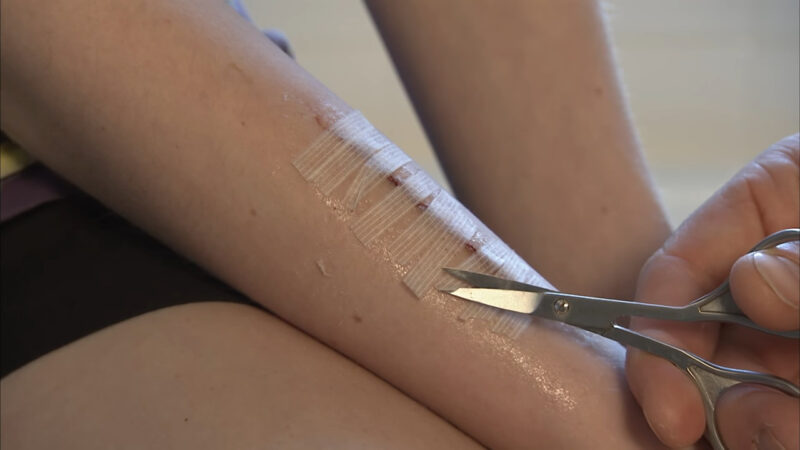Think back to your childhood at a point when you scraped your knee. You had two options: Clean it up and let it air out or place a bandage over it to stop the bleeding. Which recovery method was truly the most effective?
Contrary to popular belief, giving a wound time to breathe without a dressing doesn’t improve healing time. In fact, it may induce pain and even slow down the healing process.
Key Takeaway
- Maintaining a wound’s moisture is crucial for efficient healing, as opposed to leaving it to air out, which can slow down the healing process and increase pain.
- The choice of appropriate wound dressing is vital, with simple adhesive bandages suitable for minor cuts and more advanced dressings like hydrocolloids or alginates needed for severe wounds.
- Regular changing of wound dressings and cleaning the area with mild soap or saline solution is essential for preventing infection and promoting healing.
- SmartPAC by Advanced Tissue offers a convenient self-care system for wound management at home, providing pre-measured dressings and clear instructions to enhance independence and comfort during the healing process.
- A balanced diet rich in vitamins and minerals is important for wound healing, and medical attention is necessary for wounds showing signs of infection or those caused by animal bites or rusty objects.
What Happens when You Leave a Wound Uncovered

If we think far back to before the bandage was invented, men and women likely let their cuts and scrapes be if there wasn’t a form of dressing available. They discovered that the human body works in its own mysterious ways, forming scabs and blisters in somewhat of a natural bandage to protect the body from pain and infection.
While yes, wounds in certain circumstances can be left untouched – such as a minor scrape that doesn’t bleed – severe wounds cannot heal without moisture. Leaving it uncovered isn’t in the interest of faster healing, according to Cleveland Clinic plastic surgeon Christi Cavaliere, MD.
“Severe wounds cannot heal without moisture.”
“Airing out most wounds isn’t beneficial because wounds need moisture to heal,” Cavaliere shared. “Leaving a wound uncovered may dry out new surface cells, which can increase pain or slow the healing process.”
If you have any other questions about keeping your wound exposed, talk to your doctor for further information.
Here’s How A Covered Wound Heals Faster
By covering a wound, you contain the natural moisture that’s needed to keep the skin cells alive. Some doctors also encourage using a topical antibiotic ointment to keep the area moist, which can also reduce infection. What’s more, the simple covering of a bandage or dressing protects the area from exposure to dirt and germs and can prevent further injury from occurring.
Covering your wound offers protection and comfort, and proper dressing doesn’t even require assistance from a medical professional. SmartPAC by Advanced Tissue is designed to help you take care of your wounds independently in the comfort of your home with ease. With easy-to-understand packaging, user-friendly instructions and video tutorials, you can redress your wound and take control of the healing process without setting a doctors appointment.
Effective Wound Covering Techniques

Understanding the best practices for covering wounds is crucial in promoting faster and safer healing. The choice of dressing depends on the wound type and severity. For minor cuts and abrasions, a simple adhesive bandage is often sufficient. These bandages protect the area from external contaminants and maintain an optimal level of moisture, crucial for cell regeneration.
However, for more severe wounds, advanced dressings like hydrocolloids, alginates, or foam dressings might be necessary. These specialized dressings are designed to manage various wound exudates levels and create a protective barrier against infection. They also help in maintaining a moist environment, which is key for promoting the growth of new tissue.
In addition to selecting the right type of dressing, the technique of applying it is equally important. The wound should first be cleaned gently with mild soap and water or a saline solution. After cleaning, a topical antibiotic ointment can be applied to reduce the risk of infection. Finally, the dressing should be applied carefully, ensuring it’s secure but not too tight, as this might restrict blood flow.
Self-Care for Wound Management: SmartPAC by Advanced Tissue
SmartPAC by Advanced Tissue offers a groundbreaking approach to self-care in wound management. This system simplifies the process of wound care for patients at home, ensuring they can manage their wounds effectively without frequent visits to healthcare providers.
Each SmartPAC package contains pre-measured dressings and other necessary supplies tailored to the specific needs of the patient’s wound. This customization eliminates guesswork and reduces the risk of improper dressing application. Additionally, SmartPAC includes clear, user-friendly instructions and access to online video tutorials, guiding patients step-by-step through the process of wound care.
The convenience of SmartPAC not only promotes effective wound healing but also empowers patients to take an active role in their health care. It provides a sense of independence and control over their recovery process, which can be psychologically beneficial and enhance the overall healing experience.
Frequently Asked Questions
Can diet influence wound healing?
Yes, a balanced diet rich in vitamins and minerals, particularly Vitamin C, Zinc, and protein, can enhance the body’s ability to heal wounds.
How often should wound dressings be changed?
Typically, dressings should be changed every 24 to 48 hours, but this varies based on the wound type and condition.
Is it normal for a wound to itch during healing?
Yes, itching can be a part of the healing process, but excessive itching or irritation should be checked by a healthcare provider.
When should I seek medical attention for a wound?
If there is excessive bleeding, signs of infection (redness, warmth, swelling), or if the wound is caused by an animal bite or a rusty object, medical attention should be sought immediately.
Can weather affect wound healing?
Extreme weather conditions, like very high or low humidity, can affect wound healing. It’s important to keep the wound properly dressed and maintained regardless of weather conditions.
Are there natural remedies for wound care?
While some natural remedies might help in minor wound care, it’s essential to consult with a healthcare professional before applying any home remedies to a wound.
How does age affect wound healing?
Healing might slow down with age due to factors like reduced skin elasticity, slower cellular regeneration, and other health conditions.
Conclusion
In conclusion, the proper management of wounds is a critical component of healthcare, impacting the speed and quality of healing. While leaving minor wounds to air out might seem logical, research and medical advice suggest that maintaining a moist environment through proper dressing is more effective.







